When Should You Replace Your Running Shoes?
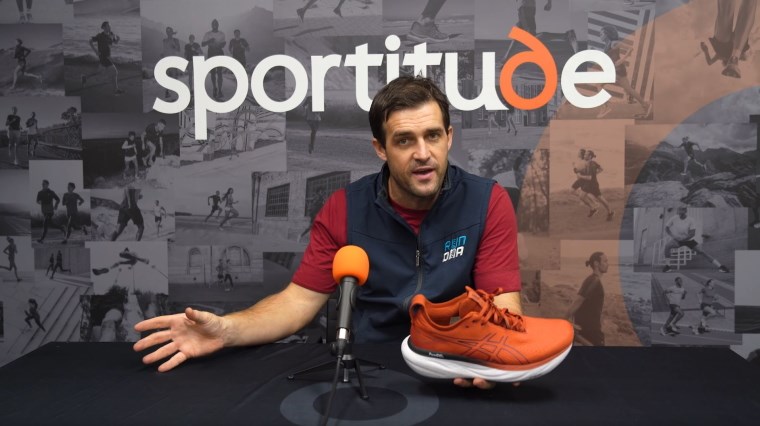
Shoe expert Josh from Sportitude Running provides insight into the common questions asked by runners around when to get a new pair of running shoes, the benefits of shoe rotation and how to phase out your old running shoes.
He dives into both the subjective data on how the running shoe feels and also the objective data, being the key markers that suggest your running shoes are ready to retire based on the condition of the upper, midsole and outsole.
Check out the video with full transcript below.
Hey guys, Josh here from Sportitude Running and today we are addressing the age-old question of “When should I replace my current running shoes?”.
As you could imagine, this question comes through hard and fast every single day at Sportitude Running. While every single runner and every single running shoe is different, we break it into two different categories.
We address what we classify as the subjective data or information, which is about you the runner telling us how you feel inside that running shoe, and there are a few variables that we consider when discussing those subjective points.
The other thing we address is the objective data points which is more around the wear pattern of a shoe. It’s about looking at how the key features of your running shoe are holding up, being the outsole, the midsole and the upper.
If you are a runner that tracks your mileage and uses that fantastic tool on Strava which collects and accumulates your mileage in one specific shoe, we can always use that as a reference point as well.
This will provide a general direction on how long shoes should last because everyone is totally different regarding weight, strike pattern and the surfaces they're using them on. You also need to consider how frequently you’re using your running shoes.
While we use that information with a grain of salt, it does give us a bit of a guideline when we're looking at those objective data points.
Subjective Data: How Does The Running Shoe Feel?
The first thing we like to address when a runner either walks into the store, emails us or phones us to contact our Sportitude shoe experts and ask, “Should I turn my running shoes over?” is, how does the running shoe feel on your foot?.
We can break that down into two parts:
- How does it feel when you put it on? Statically standing there, is it supportive? Does it feel like it’s hugging you in all the right areas like it did from day dot when you first purchased them?
- How does it feel during your run? In the first couple of hours post-run, how does your body feel as well?
There is a significant amount of variances that come into that conversation. We like to understand those key important factors around training load. That's where we start to branch out into other aspects that contribute to how you feel inside your running shoes, including:
- Have you increased your running over a small period of time be it two, three or four weeks?
- Have you changed the surface you're using your running shoes on? Going from bitumen to a rubble surface or a fire track can impact how a shoe performs and feels. Therefore, it will change how you feel post-run and during your run.
- Are you using them for just running or are you using them for some casual wear? It can be as simple as wearing them for a few hours on the weekend to do your grocery shopping, going for a coffee with friends or even something as simple as wearing them to the gym.
While it doesn't seem like walking in a shoe or wearing a running shoe at the gym will really impact the overall life of the shoe, it actually has significant impact on its longevity. A lot of times we have these conversations where someone might come into store and say, “This Asics Gel Nimbus has worn out in only 300 kilometres”.
It may be true that you've used it for 300 kilometres worth of running. However, we may dial deeper into the conversation and find out that they’ve been used three times a week for an average of 2.5 hours a day outside of running. Even by standing and walking in them, we compress that midsole and over time, the midsole does wear a little faster.
In the perfect world you'd have your running shoe and you'd isolate it just for running. The reality is we can't all do that. Just know that if you wear them casually or happen to use them in the gym for some light exercise, it will impact the overall life expectancy of that foam.
Is The Running Shoe Comfortable?
To summarise the subjective data, is the running shoe comfortable?
Put it on your foot at home and use your preferred running socks. Don't just have a business sock on your foot and expect the running shoe to feel the same as what it does with your favourite running sock.
Assess the fit and feel regarding the overall comfort:
- How does it feel during your run?
- Are you noticing it to be as cushioned and supportive as what you have previously found?
- How have you recovered inside that shoe? Post-run, are you feeling a little bit sore in the feet, heel, Achilles, calf or soleus?
We ask a lot of questions around the lower limb and how the foot actually feels post-run. It’s really important to consider whether we think you need to look at another shoe. Updating your current running shoe or looking at a different model is a whole different topic of discussion.
It’s about addressing the really key fact, how does the shoe feel? That applies to without running, while running and post-run. Ask yourself those questions and then see if we need to take the conversation further.
Now you’ve asked yourself those questions around how does the shoe feel? You may still be unsure. It is hard to understand how the shoe felt from day dot in the first zero to ten runs, to where you are right now.
As a runner, we adapt to every single condition. When a running shoe ever so slightly declines in support and comfort over time, we also adapt to make sure that shoe is doing all it possibly can for us.
It’s hard to understand if it is or isn't comfortable. Let's take a good look at the running shoes in question and see the key areas of wear to potentially get you buying another pair of shoes.
Objective Data: Condition of Upper, Midsole & Outsole
Josh takes you through used running shoes in different stages of wear to provide a clearer understanding of when to retire your running shoes.
Brooks Dyad Running Shoes
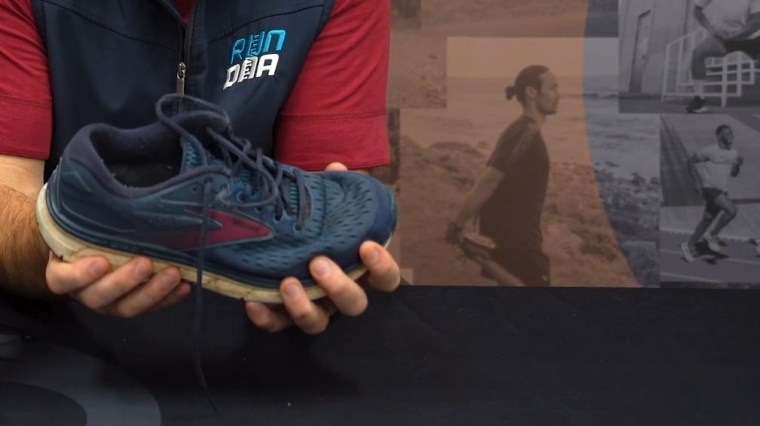
First thing first, I'll bring up this Brooks Dyad. It’s pretty well worn out. The upper has some key friction areas of wear around the forefoot, up top around the eyelets and the shoe itself is starting to lose its whole structure and integrity. Out of the pile of shoes I have down here, this is probably the most worn out. Therefore, it's a great conversation starter. It's probably gone a little bit too long in our humble opinion before we need to turn them over.
This is the running shoe of an orthotic wearer. I have to address that because an orthotic inside a running shoe actually decreases the life expectancy ever so slightly.
Brands never manufacture running shoes with orthotics in mind. It's a bit of a contentious topic of discussion because there is a large cohort of people that do rely on and use orthotics, and that is OK.
We obviously use that orthotic and put it into the right shoe to accommodate that person's running requirements. However, the shoe itself isn't built to have an orthotic inside because there are so many variables when it comes to orthotics. This includes the heel depth and width, the materials used, how wide they are, how they’re cut, where the arch support sits and whether the depth of the shoe can offer that amount of arch for that orthotic.
There are heaps of variables that we need to consider. Therefore, as I said, it's very hard for a brand to actually consider orthotics going inside their running shoes.

The runner that wore this particular Brooks Dryad has a real tendency to bow on that lateral side. You can see the upper is stretched out quite a bit. This runner did have an orthotic inside this shoe and it is a relatively stiff shoe, so they had a tendency to almost re-supinate out of their gait cycle.

How do we know that? It’s because you can see on the outsole around that fifth metatarsal that the rubber has worn right through to the cushioning component part of this midsole in comparison to where we are in the lateral side. That obviously is another discussion around the overall support.
When the outsole is wearing down to the midsole, it is definitely time to turn these running shoes over. The reason being is, if the rubber has gone down to the midsole, the midsole cushioning is going to compress very quickly if it hasn't already. Also, you've lost that support from the outsole which is really important to give you that traction and grip on those abrasive and harsh surfaces that we use them on.
The other thing we're looking at when we're addressing the overall aspects of a running shoe is how it actually looks on a flat surface. This running shoe is really tilted to the outside. You can see there's lots of stretch in this upper and heaps of puckering through the forefoot.
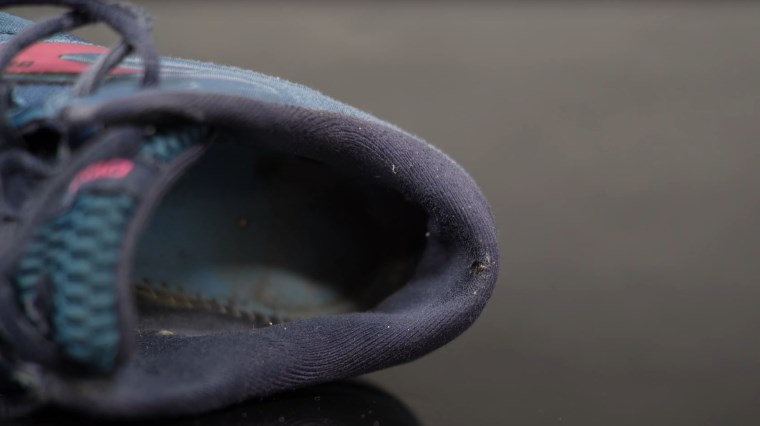
With heel counters their overall objective is to keep that heel nice and stable inside the running shoe. It's important that it has the appropriate amount of memory foam to hug the back of the Achilles and that calcaneus. The protective component of this heel counter is the plastic beam which sits from the medial around to the lateral side of this shoe.
If you're touching the internal collar of your running shoes and can feel the plastic on the inside of your shoe up high around where the padding should be, then that memory foam is compressed right back. We've lost that amount of protection and comfort at the back of the shoe.
It's pretty hard to pick that up. You need to really dial in and have a good, hard look at what it's doing inside the heel counter.
That's another key factor. How has that foam held up around the entire inside of that heel collar? Is it too worn down or is there enough support and cushioning there?
Conclusion:
This is a really obvious one, the Brooks Dyad is completely worn through. It’s well past it’s use-by date and I wouldn't even use this for mowing the lawns.
- The outsole has worn down to the midsole
- The upper has too much stretch so therefore, the forefoot would not have the support and stability it requires
- The heel collar has compressed right down to plastic internal heel counter, therefore the overall comfort of the shoe would be questionable
That's the three main areas of focus with the Brooks Dyad. We know this specific running shoe is done and we can retire the shoe.
How do we then look at a running shoe that doesn't look too bad?
New Balance Fresh Foam 1080 v11 Running Shoes
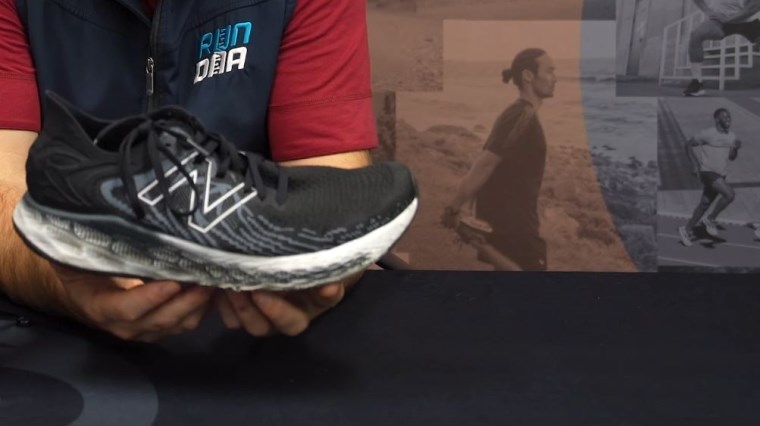
I have the New Balance Fresh Foam 1080v11 in my hand. I've grabbed this out of one of the staff member's lockers downstairs. If we're comparing it to what we just saw with the Brooks Dyad, let's look at the outsole first.
It doesn't look too bad. You can see there are some obvious wear patterns through the outsole of this running shoe which is perfectly normal. The entry point for this runner is midfoot, so you can see that exposed Fresh Foam X is starting to wear down a little bit.
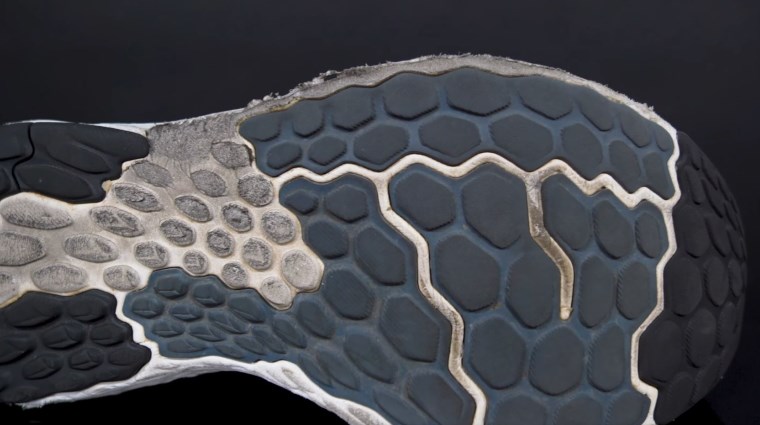
However, all in all that forefoot outsole looks pretty good. When you really look at it closely you can see that it wearing down and that's to be expected. However, it's not wearing down to a point where I'm concerned that it's going to get through to that midsole any time soon. There’s still plenty of life in the outsole configuration.
Let's jump to the midsole. Midsoles come in different shapes, sizes, geometry measurements, stack heights and heel-to-toe drops, and also materials.
You have EVA, polyurethane, TPU midsoles and even some nitrogen-infused midsoles on the market right now. They all respond differently to a multiple number of variables. It's really hard to specifically pinpoint how a nitrogen-infused midsole may look in comparison to what a Fresh Foam X midsole may look like from New Balance. We address each and every shoe engineering as its own category and we have to look at those key markers.
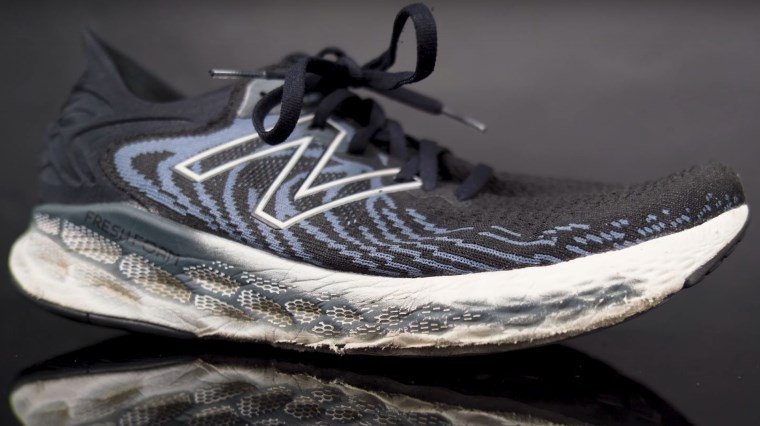
When we're looking at this New Balance Fresh Foam 1080v11, it doesn't seem too bad but you have to look close up to where the outsole of this shoe is starting to compress laterally. You have these horizontal creases starting to appear through that concave set-up.
Then you compare it to the medial side where it's more of a convex set-up towards the rear of this running shoe. Through the forefoot we’re starting to see those horizontal compression lines appear.
Conclusion:
I would say this running shoe coming towards the back end of its life expectancy. The outsole would suggest it's pretty good, but we can see the midsole is starting to wear down quite a bit.
Without those visual cues and how those creases appear inside this running shoe, we can do a bit of an old school test and I've been doing this from day dot.
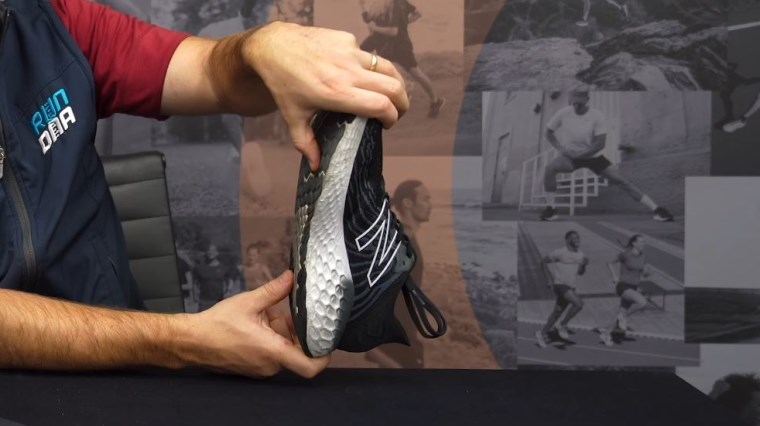
You grab your thumb, you put it in and around where your first metatarsal would sit and you see if you can get a little bit of bend. If it bends quite easily past that horizontal line of 180 degrees, it's probably lost its bounce and responsiveness through the forefoot.
I will stress that this test is going to be different in this running shoe than it would be in like a Brooks Glycerin with that nitrogen-infused midsole than it would be to a Saucony Triumph with that polyurethane midsole PWRRUN technology.
They all have different resistance and different tolerance to that test, but it's always good for us to have a look and compare it to potentially a new running shoe and consider what change occurs in that overall rigidity.
The compression lines that appear on that horizontal line inside a midsole are a pretty good indicator of how the shoe is going regarding its overall life expectancy.
Saucony Endorphin Pro 3 Racing Shoes
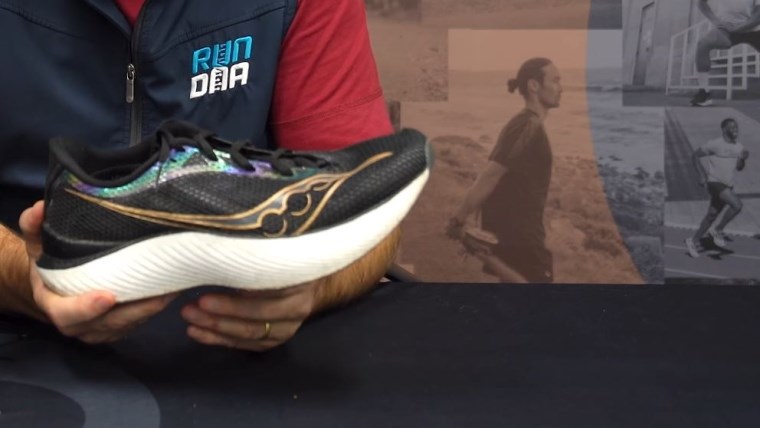
Let's quickly address the super shoe conversation. For super shoes, race shoes or whatever you'd like to call them, we know there is a significant amount of overall support and structure taken out which would indicate that the shoe is not going to last as long as your traditional mileage shoe.
It's because they're making them lighter, snappier and more responsive. Today we have carbon plates that come into the conversation as well.
Looking at these Saucony Endorphin Pro 3 running shoes, the midsole looks pretty good. That's referring to that PWRRUN PB technology from Saucony. It's really hard to see how that foam is wearing because it is a really resilient foam. It's hard to justify when that foam is compressed and worn out.
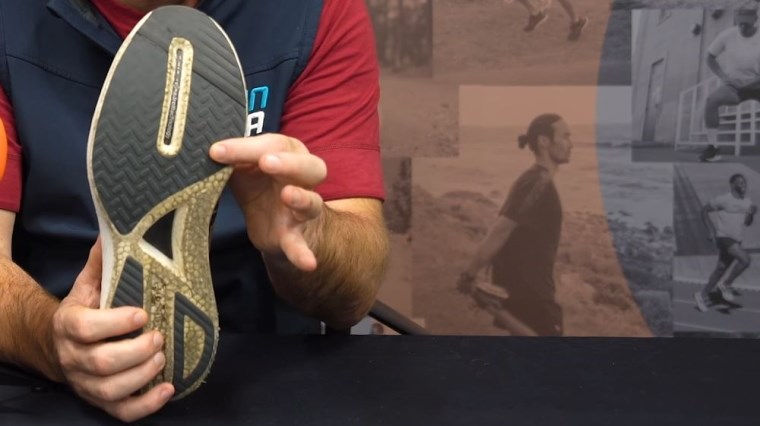
The key factor for us to look at is the outsole. Being a super shoe, we know that our vast majority of runners do re-supinate outside of their gait cycle because the plate is so stiff through the forefoot. We release outside that third, fourth or fifth metatarsal and that's certainly the case in this running shoe.
However, that outsole is starting to wear down significantly. The outsole in a super shoe isn't very durable. It's just there to protect the shoe ever so slightly. It can't be too heavy, so we tend to find with super shoes that the outsole is probably the first key indicator to suggest this running shoe is starting to lose its overall engineering outcomes and features of performance.
Conclusion:
When you dial back to your subjective conversation with super shoes, ask yourself, “Do I feel fast in this shoe?”.
You have to ask yourself that because that's what you've bought it for. You've bought it because you want to pick up the pace, you want to chase PBs or you're using it for potentially some shorter tempo or session runs in your running program.
That's quite an easy one to answer. Do I feel fast? Do I feel responsive? Am I exploding out of this shoe like I would expect regarding its overall performance factors?
Consider your answers in conjunction with the condition of the outsole, being more often than not the first thing to go in a super shoe.
When Should I Phase Out My Old Running Shoes?
Hopefully that's given you a pretty good breakdown on the key factors that we consider when we're looking at replacing our running shoes.
Just to summarise what we've discussed today, there is obviously the wear pattern within running shoes. As we talked about earlier, that Brook Dyad was a really worn-out shoe that's well passed its use by date. If a running shoe is at that point, it's certainly time to retire them.
The other topic of discussion is, when should I phase out my old or my current shoes and introduce a newer model? The answer is at around 80% of its overall life expectancy.
Your current shoe may be starting to show some signs of wear like the New Balance Fresh Foam 1080v11 as a prime example. As we touched on, the midsole is getting towards the end of its life and the outsole is not too bad.
Ideally, we can start to phase this running shoe out and introduce a new running shoe into your shoe rotation. We'll get a few more kilometres out of this running shoe to create a great entry for your new shoe. The reason being is, you're not retiring something cold turkey and starting fresh with a completely new system because you'd be so reliant on that new shoe.
The optimal transition is at around 80% of the life expectancy of your current shoes to introduce your new shoe.
Usually, the 10% rule comes into the conversation - increase the use of that running shoe by 10% every single week if that works for you.
Do I Need Two Running Shoes In My Shoe Rotation?
The other question we like to really address is, do I need two shoes in my shoe rotation? That's a conversation we have daily down here at Sportitude Running.
The answer to that is, if you have two shoes of course you're going to increase the life expectancy of both, but the reality is it's a pretty big outlay to purchase two pairs of shoes.
However, if you're someone that's running four plus times a week and you have a quite a variance in your running program – with long runs, progressive runs, tempo runs and you're looking to build up your speedwork, we would have a conversation around two pairs of shoes for you.
We may not see you for a long period of time because you’ll find your mileage running shoes are going to cater for your mileage requirements, and that lighter shoe can slip into your shoe rotation when you're looking to do those quicker progressive runs or sessions.
Therefore, you're not using your heavy mileage running shoe for that component of your training program so you won't wear the shoe down as quickly and both shoes will last a little bit longer.
On the reverse, I see it too much out there that people are using super shoes for everything. That's dangerous on a few different levels and that's another discussion in itself. However, if you are making yourself reliant on a lack of support, really snappy responsive and soft foam, you're potentially running your risk of an injury or you're going to be too reliant on that engineering system.
Remember what I said before that super shoes or racing shoes are designed to be less supportive. Components are taken out to make them lighter and therefore you're going to find that you're going to move around quite a bit inside them, but that is the whole objective with that shoe. It's to increase the velocity of movement from landing to midstance transition for a snappy release out of your gait cycle.
If you keep putting yourself in that running shoe, you are not building up the appropriate tolerance that your body requires to be strong and sustainable to support the longevity of your overall running.
When we're seeing people using super shoes for absolutely everything, they wear out so quickly. It's a big outlay, because they're not cheap to not get exactly what you expect out of them in terms of the overall longevity, so keep that in mind.
If you're buying a super shoe, please use them for what they are built for and that is racing and some speedwork. Do not use them for everything.
We understand that it's not easy to put running shoes aside and only use them for your running. If you're using your running shoes for your weekend wear, your gym sessions, going to the coffee shops and picking up your kids from sport, the midsole will wear down ever so slightly. It does compress over time and it takes a little bit extra for that shoe to recover and bounce back to its original shape.
Running shoes compress during any form of exercise - whether walking, gym or running. We need to give some time for the running shoe to come back to its original size, and that changes per engineering and technologies within every single shoe.
Shoe Rotation Trick
I want to share one trick regarding transitioning your old shoes and introducing a new shoe in your rotation around that 80% life expectancy mark.
I would strongly encourage when you have your running shoes at that 80 to 20 split, with your new shoes now making up 80% of your current running program, it's A-OK to use your older shoes for some casual wear.
There'll be enough cushioning and life in them to wear them on the weekends and go to the shops. Just keep your fresh kicks put aside for your running and training program only and by the time that shoe becomes 80% cooked, the same cycle continues. You introduce a new shoe and phase your current running shoes into your casual shoe offering.
How To Increase The Life Expectancy Of Your Running Shoes
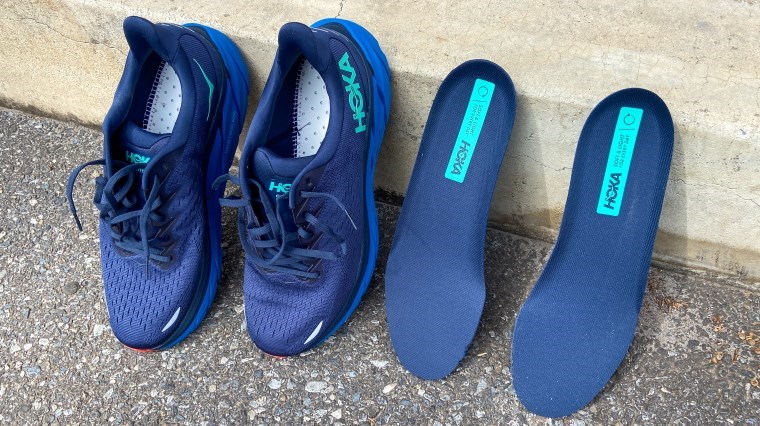
The other thing we'd like to address is some ticks and tips on increasing the life expectancy of your running shoes.
1. Undo your shoelaces after every single run.
I get it, sometimes we're tired, we're breathing heavily and we just want to kick the shoes off of our feet.
However, if you take five seconds to undo and loosen those laces to take them off, you will increase the life expectancy of the heel counter considerably.
When people don't undo their laces and they kick their shoes off, we find they push right into the back of the heel counter and it can compress a crack.
It’ll also affect the engineering of that heel counter to the point where it's not even functioning as a proper heel counter. We do not want to do that. Undo your shoelaces, it's my number one tip and trick.
2. Don't put your running shoes in the washing machine
I know that's a contentious issue because a lot of people wonder, how do I clean my new running shoes?
By putting them in the washing machine the stitching, engineered mesh and the jacquard mesh can be damaged. If it's soaked in water for too long it becomes quite soft. When it dries it can become brittle because the engineering in uppers is designed to be light, breathable and compliant.
When you're playing around with how that actual structure works, you may impact the overall performance and the longevity of the upper.
You can use shoe cleaning products which we have at Sportitude Running under shoe care. Otherwise, you can clean them with a dry shampoo which will do a pretty good job. However, please do not put them in the washing machine.
When you've used them in the middle of winter and we're coming to those months now here in Australia where there's going to be a lot of rain and water around, try not to put your shoes in front of a fire or a dryer.
When they go from being wet to drying really quickly, you run the risk of the upper shrinking a little bit and becoming quite brittle. Try to put them in a relatively dry climate at room temperature and yes, it will take a little bit longer for them to dry.
Alternatively, if you have access to paper towels grab a lot of paper towels and stuff them inside the shoe. That paper towel will absorb the moisture and speed up that drying process for you.
3. Take your sockliner or orthotic out of your running shoes
With drying your shoes, I strongly recommend taking out your sockliner or your orthotic if you're using one.
A sockliner is a glorified sweat catcher for a lot of people. They provide a bit of comfort (not cushioning) and protection from the strobel board and midsole of the running shoe.
They collect a lot of moisture, so by taking it out of the shoe and either placing it next to it or upright against the heel counter it will allow the shoe to dry out a little bit quicker. It’ll also rid the shoe of all those nasty odours that can appear.
Sneak Peek Into Part 2: What New Running Shoes Should You Look For?
That was Part 1 of today’s discussion in and around what key factors we consider when changing your shoes. Part 2 is What New Running Shoes Should You Look For?
It’s the fun part of most of the discussion and to be honest that's pretty much why Sportitude Running exists. We are here to solve that problem for you the running community.
We’ve come from X and we’re looking to go to Y. What are we looking for and where can we make some subtle improvements with your overall shoe selection?
The one constant variable in this industry is that every 12 months shoes change. Sometimes it's minor changes from one model to the next and sometimes it's significant changes.
We know from the Asics Gel Nimbus 24 to the Asics Gel Nimbus 25 was a huge change for example, so we need to take into consideration a whole heap of discussion points to point you in the right direction. That's what Part 2 is going to be about.
I hope you've taken away quite a bit of information and I know it's been an information overload. If you have any questions, comments, queries or if you have any tips that we haven't covered regarding your running shoe's life expectancy or turning them over, please contact our Sportitude shoe experts.
We'd love to hear from you, the entire running community all around the world. Until next time, stay safe, be kind to one another and make sure you're turning your shoes over at the right time.
We'll see you out on the road. Take care.
For guidance on how to recycle or repurpose your pre-loved running shoes and running clothing, check out Sportitude's partnership with UPPAREL.
If you liked this, you'll love:
What To Do When Your New Running Shoes Arrive?
How To Break In Your New Running Shoes
How To Clean And Care For Your New Running Shoes
What Type Of Running Shoe Is Best For Me?
